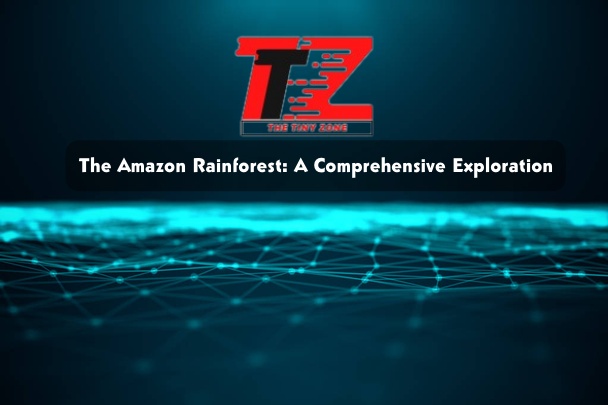Introduction
The Amazon Rainforest, often referred to as the “Lungs of the Earth,” is the largest and most biodiverse tropical rainforest in the world. Covering a vast expanse across South America, the Amazon Rainforest is a complex and critical ecosystem that plays a vital role in regulating global climate, supporting countless species of flora and fauna, and providing essential resources to millions of people. In this 3000-word article, we will delve into the Amazon Rainforest’s geography, biodiversity, ecological significance, and the ongoing challenges it faces.
1. Geographic Location and Extent
The Amazon Rainforest is primarily located in South America, spanning across nine countries: Brazil, Peru, Colombia, Venezuela, Ecuador, Bolivia, Guyana, Suriname, and French Guiana. It covers an astonishing area of approximately 5.5 million square kilometers (2.1 million square miles), making it the largest rainforest on Earth. The Amazon Basin, which includes the rainforest, is drained by the Amazon River, the second-longest river globally, after the Nile.
2. Climate and Seasons
The Amazon Rainforest experiences a tropical climate characterized by high temperatures and abundant rainfall throughout the year. There are two main seasons: the wet season and the dry season. During the wet season, which typically occurs from December to May, heavy rains lead to swollen rivers and flooded forests. The dry season, from June to November, brings drier conditions with occasional forest fires.
3. Biodiversity and Flora
The Amazon Rainforest is renowned for its unparalleled biodiversity, hosting a vast array of plant species. It is estimated that the Amazon is home to over 390 billion individual trees belonging to approximately 16,000 species. Some of the most iconic and valuable tree species include the Brazil nut tree, rubber tree, and mahogany tree.
The forest floor is carpeted with an intricate web of plant life, including ferns, mosses, and countless species of flowering plants. Orchids, with their dazzling variety of colors and shapes, are among the most famous floral inhabitants of the Amazon.
4. Fauna of the Amazon
The Amazon Rainforest is a treasure trove of wildlife, with an astonishing number of species. It is estimated that the Amazon Basin is home to one-tenth of all known species on Earth. Some of the most iconic and charismatic animals of the Amazon include:
- A. Jaguars: The Amazon Rainforest is one of the last strongholds of the jaguar, the largest big cat in the Americas.
- B. Sloths: Three-toed and two-toed sloths are famously slow-moving and well-adapted to life in the treetops.
- C. Macaws and Parrots: The Amazon is home to a dazzling array of brightly colored parrots and macaws.
- D. Poison Dart Frogs: These small, vibrant frogs are known for their toxic skin secretions used by indigenous people for blow darts.
- E. Pink River Dolphins: The Amazon River is home to the rare and endangered Amazon river dolphin, which can be pink in color.
- F. Capybaras: Capybaras, the world’s largest rodent, are often seen lounging near water bodies.
- G. Anacondas: The green anaconda, one of the world’s largest snakes, inhabits the Amazon’s swamps and rivers.
- H. Howler Monkeys: These primates are known for their loud and distinctive vocalizations that can be heard throughout the forest.
5. Indigenous People and Culture
The Amazon Rainforest is not only a biological wonder but also a cultural treasure. It is home to numerous indigenous groups with unique languages, traditions, and lifestyles that have adapted to the rainforest’s challenging environment. These indigenous communities play a vital role in the preservation of the forest and its biodiversity.
Many indigenous people rely on traditional knowledge of the forest’s resources for their livelihoods. They practice sustainable hunting, fishing, and farming techniques that have been passed down through generations.
6. Ecological Significance
The Amazon Rainforest has far-reaching ecological significance, impacting the entire planet in several ways:
- A. Carbon Storage: The Amazon acts as a crucial carbon sink, absorbing and storing vast amounts of carbon dioxide, a greenhouse gas responsible for global warming. The trees and vegetation in the Amazon help regulate the Earth’s climate by reducing the concentration of carbon dioxide in the atmosphere.
- B. Biodiversity Hotspot: The Amazon’s rich biodiversity is of global importance. Many species found here are endemic, meaning they exist nowhere else on Earth. Protecting the Amazon is essential for the preservation of these unique life forms.
- C. Water Cycle Regulation: The Amazon Rainforest plays a vital role in regulating the planet’s water cycle. Through a process called transpiration, trees release water vapor into the atmosphere, which eventually forms clouds and contributes to rainfall not only within the Amazon Basin but also in other parts of South America and beyond.
- D. Amazon River: The Amazon River, fed by countless tributaries originating in the Andes Mountains, is a lifeline for both the rainforest and the people who inhabit its banks. It provides water, transportation, and fish for millions of people.
7. Threats to the Amazon Rainforest
Despite its ecological importance, the Amazon Rainforest faces numerous threats, including:
- A. Deforestation: One of the most significant threats to the Amazon is deforestation, primarily driven by logging, agriculture, and infrastructure development. Large tracts of forest are cleared to make way for soybean and cattle farming, leading to habitat loss and fragmentation.
- B. Climate Change: The Amazon is vulnerable to the effects of climate change, including droughts, which can lead to forest fires and tree mortality. Rising temperatures also impact the delicate balance of the rainforest ecosystem.
- C. Illegal Logging and Wildlife Trade: Illegal activities such as logging and wildlife trafficking contribute to the destruction of the Amazon’s biodiversity.
- D. Mining: Mining for minerals and precious metals can result in habitat destruction, pollution of waterways, and displacement of indigenous communities.
- E. Infrastructure Development: The construction of roads, dams, and other infrastructure projects can fragment the rainforest, disrupt ecosystems, and facilitate further deforestation.
8. Conservation Efforts
Efforts to protect the Amazon Rainforest and its biodiversity are ongoing, involving governments, environmental organizations, and local communities. Conservation strategies include the establishment of protected areas, sustainable forestry practices, and initiatives to combat illegal logging and deforestation.
International agreements and partnerships also play a role in conserving the Amazon, as its ecological significance extends beyond national borders.
Conclusion
The Amazon Rainforest stands as a natural wonder of the world, teeming with biodiversity and ecological significance. Its preservation is crucial for mitigating climate change, maintaining global biodiversity, and respecting the cultural heritage of indigenous communities. As we confront the challenges posed by deforestation, climate change, and unsustainable development, it is essential that we continue to work together to protect this irreplaceable ecosystem for current and future generations.


